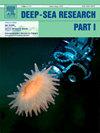Combined influence of strong winds and warm deep water on the formation of Amundsen Sea Polynya in winter
IF 2.1
3区 地球科学
Q2 OCEANOGRAPHY
Deep-Sea Research Part I-Oceanographic Research Papers
Pub Date : 2025-07-31
DOI:10.1016/j.dsr.2025.104561
引用次数: 0
Abstract
Polynyas play an important role in climate change by enhancing heat and material exchange between the atmosphere and the ocean in polar regions. This study investigated the influence of strong winds and warm deep water on the Amundsen Sea Polynya (ASP), with a particular focus on ASP events during the winter of 2014. The ASP is located directly above the underwater Bear Ridge, with its shape corresponding to the topography. The ASP is more frequently observed on the eastern side than on the western side, due to the influence of the iceberg chain (fast ice) east of the ASP and prevailing southeast winds. However, we found that the occurrence frequency of the ASP is highest in the shallowest points of the topography, rather than near the iceberg chain on the easternmost side. This is related to the upwelling of warm deep water driven by topography. The upward mixing of warm water with the surface waters inhibits sea ice formation and growth there, helping to maintain the ASP on the east side of the Bear Ridge top. Given the potential for a warmer subsurface ocean around Antarctica in the future, enhanced warm deep water mixing could further impact the thermodynamics of the ASP.
冬季强风和温暖深水对阿蒙森海冰海形成的综合影响
冰裂湖通过加强极地大气和海洋之间的热量和物质交换,在气候变化中发挥着重要作用。本研究考察了强风和温暖深水对阿蒙森海冰海(ASP)的影响,特别关注了2014年冬季的ASP事件。ASP位于水下熊岭的正上方,其形状与地形相对应。由于受东副极以东的冰山链(快冰)和盛行的东南风的影响,东副极比西副极更常被观测到。然而,我们发现ASP的发生频率在地形的最浅点最高,而不是在最东侧的冰山链附近。这与地形驱动的温暖深水上涌有关。温暖的海水与地表水向上混合,抑制了那里海冰的形成和生长,有助于维持熊脊顶部东侧的平均温度。考虑到未来南极洲周围的地下海洋可能会变暖,增强的温暖深水混合可能会进一步影响ASP的热力学。
本文章由计算机程序翻译,如有差异,请以英文原文为准。
求助全文
约1分钟内获得全文
求助全文
来源期刊
CiteScore
4.60
自引率
4.20%
发文量
144
审稿时长
18.3 weeks
期刊介绍:
Deep-Sea Research Part I: Oceanographic Research Papers is devoted to the publication of the results of original scientific research, including theoretical work of evident oceanographic applicability; and the solution of instrumental or methodological problems with evidence of successful use. The journal is distinguished by its interdisciplinary nature and its breadth, covering the geological, physical, chemical and biological aspects of the ocean and its boundaries with the sea floor and the atmosphere. In addition to regular "Research Papers" and "Instruments and Methods" papers, briefer communications may be published as "Notes". Supplemental matter, such as extensive data tables or graphs and multimedia content, may be published as electronic appendices.

 求助内容:
求助内容: 应助结果提醒方式:
应助结果提醒方式:


